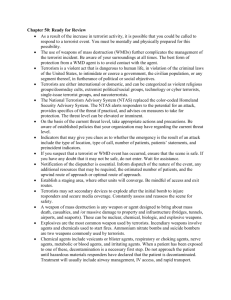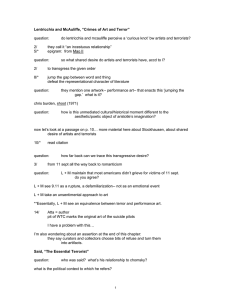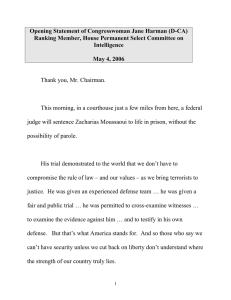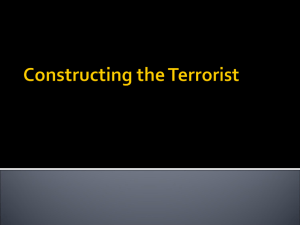Hybrid Complex Adaptive Engineered Systems: A Case Study in Defence
advertisement
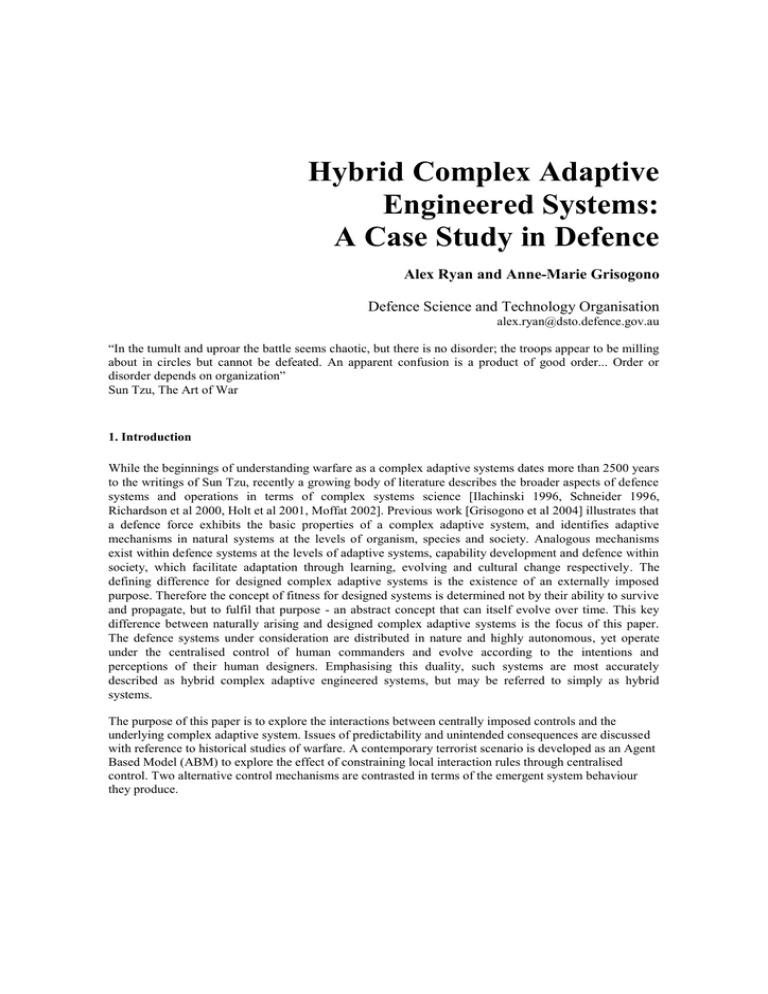
Hybrid Complex Adaptive Engineered Systems: A Case Study in Defence Alex Ryan and Anne-Marie Grisogono Defence Science and Technology Organisation alex.ryan@dsto.defence.gov.au “In the tumult and uproar the battle seems chaotic, but there is no disorder; the troops appear to be milling about in circles but cannot be defeated. An apparent confusion is a product of good order... Order or disorder depends on organization” Sun Tzu, The Art of War 1. Introduction While the beginnings of understanding warfare as a complex adaptive systems dates more than 2500 years to the writings of Sun Tzu, recently a growing body of literature describes the broader aspects of defence systems and operations in terms of complex systems science [Ilachinski 1996, Schneider 1996, Richardson et al 2000, Holt et al 2001, Moffat 2002]. Previous work [Grisogono et al 2004] illustrates that a defence force exhibits the basic properties of a complex adaptive system, and identifies adaptive mechanisms in natural systems at the levels of organism, species and society. Analogous mechanisms exist within defence systems at the levels of adaptive systems, capability development and defence within society, which facilitate adaptation through learning, evolving and cultural change respectively. The defining difference for designed complex adaptive systems is the existence of an externally imposed purpose. Therefore the concept of fitness for designed systems is determined not by their ability to survive and propagate, but to fulfil that purpose - an abstract concept that can itself evolve over time. This key difference between naturally arising and designed complex adaptive systems is the focus of this paper. The defence systems under consideration are distributed in nature and highly autonomous, yet operate under the centralised control of human commanders and evolve according to the intentions and perceptions of their human designers. Emphasising this duality, such systems are most accurately described as hybrid complex adaptive engineered systems, but may be referred to simply as hybrid systems. The purpose of this paper is to explore the interactions between centrally imposed controls and the underlying complex adaptive system. Issues of predictability and unintended consequences are discussed with reference to historical studies of warfare. A contemporary terrorist scenario is developed as an Agent Based Model (ABM) to explore the effect of constraining local interaction rules through centralised control. Two alternative control mechanisms are contrasted in terms of the emergent system behaviour they produce. 2 2. Issues for the design of hybrid complex adaptive engineered systems There are a number of issues related to the design of hybrid systems. Lucas [1999] contains a list of potential problems for implementing complexity theory as a computing paradigm, many of which are relevant to designing hybrid systems in defence. For example, one problem is how to identify and repair inappropriately evolved systems, meaning those systems that fail to meet their design objectives. This is clearly a valid concern, since brains can suffer mental illness, species become extinct and market economies crash. In each case, the feedback mechanisms have pushed the system into an attractor state that is adverse to some fitness concept (such as continued survival or propagation) and unless these mechanisms are altered or supplemented there is nothing to indicate that system performance will revert to a more favourable attractor. Most systems in this state require external stimulus in order to restore preferred behavioural patterns. For a defence system this role could be performed by the system designer, similar to the way a reserve bank monitors a national economy and adjusts the official interest rate. However, this identifies a requirement for continual monitoring and feedback, as well as appropriate mechanisms for system repair when defective behaviour is identified. The way these types of mechanisms could interact with the underlying complex adaptive system is not currently well understood, and controlling a complex system such as an economy or a defence force by altering a single variable is both difficult and unreliable. Central to this problem, and to the most important issues relating to the design and control of complex adaptive engineered systems, are two concepts: predictability and unintended consequences. 2.1. Complex adaptive systems are unpredictable Predictability is often considered an imperative for military systems, since warfare is a chaotic system. Microscopic state differences can lead to macroscopic state changes over relatively short time scales. This is the meaning behind the term “strategic corporal” coined by General Krulak [1999]. This describes how the decisions made by a Corporal in a humanitarian aid situation can within a matter of minutes either lead to the defusion of a potentially violent situation, or if the wrong decisions are made, to far-reaching strategic effects capable of jeopardizing the mission [Krulak 1999]. An essential role of training, doctrine, rules of engagement and much of military command and control then, is to suppress variation that can potentially produce undesirable macroscopic state change. Taken to an extreme, this urge to suppress variation and constrain the available degrees of freedom can lead to a very brittle and unstable solution. As the strategic environment changes, the lack of variation inhibits the force’s ability to adapt. Given that a trade-off exists between predictability and robustness, it may be instructive to review the use of inherently unpredictable systems. A simple example is the use of horses in warfare. Since we lack a deep understanding of the cognitive processes of the horse, the behaviour of a 500kg horse that has been spooked is both unpredictable and dangerous. Nevertheless they played a decisive role in combat for over five thousand years up to and including World War I, epitomised by the capture of Atahuallpa by Pizarro in 1532 [Diamond, 1999]. Rodney Brooks [pers. comm. 2004] suggests this is because people have developed an understanding of the parameters under which horses behave favourably. Provided the horse is well fed and we don’t light a match next to its eye, a level of trust can be established within this set of parameters through the trial and error of experience, even though we cannot predict the behaviour of an individual horse in an individual situation. Therefore a loss of certainty in system behaviour can be justified provided other benefits, such as robustness or decisiveness in combat, can be realised. Since ths paper takes the view that warfare is a complex adaptive socio-technical system, it follows that despite all efforts to exercise control the system will be inherently unpredictable. Attention should be focused on understanding rather than suppressing complexity. 3 2.2. Changing a complex adaptive system has unintended consequences In any complex adaptive system where centralised control is imposed in order to improve some measure of system performance, it is common to observe a raft of unintended consequences. In some cases the unintended effects of change designed to improve a measure can actually result in a decline. The cause is naturally arising feedback loops. The following recorded historical examples will illustrate how formal adaptive mechanisms have been hampered by naturally arising feedback loops. 2.2.1. Artillery in the Battle of the Somme An account of the Battle of the Somme from a technological perspective is given in [Brodie et al 1973]. The firepower of the machine gun was so devastating that both sides were forced underground into trenches extending from Switzerland to the North Sea, protected by hundreds of thousands of miles of barbed wire and other obstacles. The tactical problem Allied high command faced was one of penetration to end the stalemate. The solution they pursued for two and a half years as the key to success was prolonged bombardment. A belief in this solution persisted despite repeated failures, such as the Third Battle of Ypres in 1917. A year’s production of shells for 55,000 war workers were fired over nineteen days, yet only forty-five square miles were taken in five months at a cost of 370,000 men. To understand why this strategy ended in mass slaughter rather than the desired penetration it is necessary to identify the unintended consequences. Firstly the bombardment shattered the ground, and rain turned the battlefield into a “chaos of mud and swamp” [Brodie et al 1973], making penetration more difficult, rather than easier. Secondly, the bombardment signalled the intention to advance, meaning surprise was impossible and enemy reserves were ready in place. In combination, these features of the system produced an effect opposite to the intended effect. 2.2.2. Moral hazard and bias in peacekeeping The issues of moral hazard and bias in peacekeeping and humanitarian aid situations relates to the concept of unintended consequences. The issue of moral hazard is summarised by the question “can actions taken by third parties to forestall violence actually encourage it?” [Carment 2001]. Carment submits that belligerents utilise the security, food and medical aid provided by third parties as a public good, reducing the risk of combat and increasing the incentive to pursue gains through violence. The bias of taking sides during intervention can encourage violence and result in escalation, such as the NATO involvement in Kosovo. In this case, NATO statements bolstered the Kosovo Liberation Army (KLA) and resulted in military growth, strengthened numbers and increased international legitimacy. The KLA then used ceasefire talks to improve their fighting capacity and reoccupy territory lost in the previous year [Carment 2001]. Once again, the effect of changing the system is opposite to the intended effect. 2.2.3. The Pentropic Army In 1956-60 the US Army undertook a restructuring in response to the shift in strategy away from the expense of a large ground force towards a nuclear policy [Kedzior 2000]. The Pentomic division was designed to withstand nuclear attack through dispersion, but able to mass quickly to employ a tactical nuclear response. Australia implemented a similar model called the Pentropic division in 1960-65 with the intention of improving interoperability with Australia’s main ally, and improving the Army’s capability in the nuclear age. However, both interoperability and capability decreased under the restructure. Roger Lee, head of the Australian Army History Unit, explains how this occurred [Lee pers. comm. 2004]. Current 4 operations in Malaysia as part of the conventionally structured British Commonwealth Far East Strategic Reserve required battalions to reorganise from Pentropic to standard British Commonwealth battalion structure before service. In addition, the US Army abandoned the Pentomic divisional structure in 1961, leaving Australia interoperable with none of its allies. The restructuring of the Pentropic battalions, now commanded by a full Colonel, resulted in a large rank gap between the commander and the OCs (Officer Commanding) of the supporting elements. Consequently OCs did not voice their concerns to the Battalion commander resulting in command failures. Other problems were that a full Colonel may be too old to cope with a field command, and at the next higher command level, the battle group, there was too wide a span of command. Finally, the demise of the CMF Army Reserve, once an important capability, has been attributed to the introduction of the Pentropic division. An accumulation of unintended consequences overwhelmed any positive effects of the restructure and the Pentomic structure was abandoned in 1965. 3.0. Shaping emergent complex adaptive behaviour The previous section identified different instances of centralised changes to complex adaptive systems producing unpredicted effects on system behaviour, often for the worse. The obvious question is: can centralised control shape emergent behaviour to improve system performance? An Agent Based Model (ABM) is developed to explore how centralised control influences natural interactions at the individual agent level. The ABM can be considered a distillation, meaning the minimum set of features of a real world situation is included in the model. This is both the greatest strength and weakness of the distillation approach to agent based modelling. An austere representation provides the clearest understanding of the dynamics of the mechanisms under investigation, in the same way as an experimentalist will go to great lengths to construct a laboratory environment where external influences are removed. The disadvantage of this approach is the particular insights cannot be directly applied to the real world without consideration of many subtleties. A large number of equally valid simple models can be derived from the same complex real world situation. A considerable limitation of all ABMs is the implementation of human decisionmaking as a fixed rule set. Even if heuristic learning algorithms and adaptive rules are incorporated, it is clear that the current state of the art in Artificial Intelligence falls well short of human abilities for cognition, intelligence, invention and adaptation, all of which affect the outcome in socio-technical systems. 3.1 Terrorist scenario With the caveat that the following model demonstrates potential dynamics in a hybrid complex adaptive engineered system, rather than proposed solutions to real world situations, the model is now introduced. An issue motivated group is using violence as a method for achieving its goals. The indiscriminate use of violence against civilian targets has led to the group being referred to as terrorists in the international media. The government is under pressure to resolve the situation quickly with the minimum bloodshed, and the terrorists are not open to negotiation. Terrorist bombings have led to public outrage and calls for retaliation. However, retaliatory strikes seem to only have increased the terrorists’ resolve and led to a cycle of violence with civilians caught in the crossfire. Military options that provide the required level of survivability against armed terrorist threats cannot guarantee a level of precision capable of preventing innocent casualties. An alternative approach has been tabled in parliament. An immediate cessation of retaliatory strikes combined with a doubling of police presence will discourage the gathering of terrorists. It is argued that over time this will reverse the negative publicity of civilian casualties, and as the population rejects the violent methods of the terrorists, their support and recruiting base will contract. 5 3.2 NetLogo model A model is now developed in order to contrast the control mechanisms representing the two approaches to the terrorist problem outlined in the previous section. The terrorist scenario is implemented in NetLogo [Wilensky 1999] as a multi agent system. Interaction rules at the agent level are specified and aggregate system behaviour is described as being emergent from the local interactions. As the parameter space is explored by changing interactions it is possible to measure a change in the emergent behaviour of the system state over time. The local interaction rules are described in Table 1 below. The model contains five types of entities: civilians, terrorists, police (these could represent a police or military peacekeeping force), military aerial weapon systems (these could equally well represent fighter jets, homing missiles or attack helicopters, subsequently referred to as jets) and bombs. Civilians and terrorists live for 70 turns, and police numbers are maintained constant. All new entities are born as civilians and terrorists must recruit from the civilian population to increase in number. The civilian birth rate is approximately equal to the death rate. Movement for all entities except jets is linear in a random direction. The jets travel at three times the speed of other units and track a particular target. When a jet drops a bomb it explodes immediately. Terrorist bombs explode each turn with a 20% chance. This means the probability a bomb kills the terrorist who planted it is the probability the terrorist does not escape the blast radius of 3 squares. This equals 1 - (1-0.2)3 = 0.488, which means that 49% of terrorists are suicide bombers. In the case that the terrorist escapes the explosion, a jet is dispatched to drop a bomb on the terrorist. Rule Plants a bomb every 10 turns 10% chance of recruiting neighbouring civilians Police Terrorist Discourage Terrorist will not recruit civilians if police are present Bomb All except jets Kill All units in radius 3 die. Jet Terrorist Bomb If a terrorist bomb explodes, the responsible terrorist is tracked and bombed. Civilian Jet Bomb Convert If a jet bomb causes civilian casualties, all witnesses are converted into terrorists Table 1. Local interaction rules for a NetLogo agent based model. Terrorist Terrorist Interacting Entities Bomb Civilian Interaction Plant Recruit The model captures each feature of the scenario as a number of simple local interaction rules. Figure 1 below illustrates a NetLogo simulation in progress. Jets and police are coloured blue, civilians are coloured white, bombs are coloured black and terrorists are coloured red. Terrorist bomb explosions are red, while explosions of bombs dropped by jets are pink. If jet bomb explosions cause any civilian casualties, the civilians who witness the explosion (within two squares) are converted into terrorists and displayed in pink, rather than red. The initial settings are 100 civilians, 10 police and 10 terrorists. A jet entity is created each time there is a new mission. This assumes that there are more jets available to the government than retaliation missions at all times. 6 Figure 1. NetLogo Agent Based Model of terrorism scenario. To establish the effect of different local interaction rules on the level of terrorist activity the model is replicated twenty times for four parameter settings. The first setting is the current policy of retaliation against terrorist bombers and the current police levels. The second setting doubles the number of police while continuing retaliation. The third setting does not launch retaliation strikes against terrorist bombers and maintains current police levels. The fourth setting both removes retaliation and doubles police staffing. A simulation is run for each setting for 1000 time steps or until the number of terrorists reaches zero. The system variables measured to gauge the success of different settings are the number of bomb explosions and the number of lives lost from both terrorist and jet activity after 1000 steps, the average number of terrorists alive per time step, the average number of time steps each replication runs for, and the number of runs where there are no terrorists left after 1000 time steps. The results averaged over twenty replications are shown in Table 2 below. Setting one Retaliation Police = 10 711 2307 254 743 30 930 3 Setting two Retaliation Police = 20 382 1243 141 412 19 678 11 Terrorist bombs Terrorist kills Jet bombs Jet kills Num terrorists Ave Time Steps Num runs where terrorists die out Table 2. Results of 20 NetLogo replications. Setting three No Retaliation Police = 10 172 530 0 0 11 431 16 Setting four No Retaliation Police = 20 90 271 0 0 8 308 20 7 When the model is replicated for setting two and compared to setting one (see Table 2 above), both the number of bombs planted and number of casualties from bomb explosions are reduced by over 45% by doubling the police presence. The average number of terrorists per time step is reduced from 30 to 19, although for both settings this is still greater than the simulation’s starting value of 10 terrorists, which shows a growth in the number of terrorists over time. The number of retaliatory strikes reduced from 254 to 141, resulting in 218 less casualties. For setting one the terrorists died out in only 3 of the 20 replications within 1000 iterations, and the average replication length was 930 time steps. With police numbers doubled to 20 in setting two 11 replications terminated and the average replication length was reduced to 678 steps. From this data we can conclude that the police presence has had a significant positive impact on the level of terrorist activity, the number of retaliatory strikes required and the likelihood that terrorism is eliminated completely. This result could be expected, although it is interesting that inhibiting one mechanism for recruiting new terrorists has such a large impact. Less intuitive is that by prohibiting targeted bombing of terrorists through retaliatory strikes, the average number of terrorists, and therefore the average time steps, the number of terrorist bombings and killings all reduce. For setting three, the improvements are greater than setting two. The reason is that although the jet bombings target and kill on average 254 terrorists, as a side effect it converts an average of 299 civilians into terrorists. These extra 45 terrorists over the life of the simulation represent 23% of the terrorist population, which has a multiplier effect to increase terrorist killings by 77% from 530 to 2307. In setting four, which prohibits retaliation and doubles the police presence, the best results are achieved. The number of bombings is reduced to 90, the average number of terrorists is 8, which is lower than the initial conditions, and all 20 replications terminate within 1000 time steps. Statistically, using a twosample single tailed t-procedure, the difference in terrorist activity (measured by the number of exploded terrorist bombs) between setting one and setting four is significant at the 99.95% confidence level, and the t-statistic is 9.82 which is much larger than the critical value of 3.88. Despite the high significance, a note of caution should be raised at this result, since the data is not normally distributed and contains outliers, which affects the validity of the t-procedure for a sample size of twenty replications. Other analyses of ABMs [Lauren, 2000, 2001] suggest the data displays fractal characteristics due to correlations between entities in both space and time. Consequently modelling the ensemble as a statistically scaling system may be more appropriate. 3.3 Conclusions The ABM simulates two mechanisms for centralised control within a complex adaptive system. In the model autonomous agents make decisions based on local interactions. Both mechanisms are intended to reduce the number of terrorists. The retaliation mechanism, which operates by directly reducing the number of terrorists, is subverted by local interactions and consequently has the opposite effect of increasing the number of terrorists and bombings. The policing mechanism is less direct, since it does not kill or detain existing terrorists, nor prevent them from bombing. However, it does inhibit the recruitment of new terrorists leading to decay in the terrorist population over time. The policing mechanism can be understood to be operating on a longer time scale over several generations of terrorists, rather than the short-term strategy of retaliating against individual terrorist attacks. The model is intentionally simple compared to the historical examples discussed earlier and only contains a small number of feedback loops. As more interaction types are added to the model, interference between feedback loops may increase the complexity of the model’s behaviour. Many more counter-intuitive effects of centralised control measures may be revealed, but this model demonstrates a low complexity threshold for the emergence of unintended consequences. Most importantly this model illustrates how indirect action altering the context in which local interactions take place can be more effective than centrally imposed policies focussed on directly improving a single system measure or benchmark in hybrid systems. 8 4.0 Summary In designed complex adaptive systems, human design and engineering mechanisms interact with the naturally arising adaptive mechanisms to produce a partially emergent, partially engineered system. Exploring the implications of conscious human design decisions driving the emergent functionality of a CAS, the possibility for spontaneously arising informal adaptive feedback loops to undermine deliberate, formal adaptive mechanisms was demonstrated. The potential for hybrid systems to harness the benefits of the underlying adaptive systems while utilising intelligent design effort to shape the emergent system function effect was illustrated using an agent based model. The results may provide basis for a new understanding for effective change within hybrid systems and have implications for system design, capability development and force transformation within defence. References Brodie, B. & F.M. Brodie, 1973, From Crossbow to H-Bomb: The evolution of the weapons and tactics of warfare, Indiana University Press, Bloomington. Carment, D., 2001, The Struggle for Peace - Rethinking Intervention, Vol 23, Issue 2. http://www.hir.harvard.edu/articles/index.html?id=902 Diamond, J., 1999, Guns, Germs, and Steel: The Fates of Human Societies, W.W. Norton & Company, NY. Grisogono, A., Ryan, A.J., 2003, Designing Complex Adaptive Systems for Defence, Systems Engineering Test and Evaluation Conference, Canberra. Holt, C.G. & E.B. Dent, 2001, CAS in War, Bureaucratic Machine in Peace: The U.S. Air Force Example, Emergence: The Journal of Complexity in Management and Organizations, Vol 3, Issue 3, 90-107. Ilachinski, A., 1996, Land Warfare and Complexity, Part II: An Assessment of the Applicability of Nonlinear Dynamics and Complex Systems Theory to the Study of Land Warfare, Virginia: Center for Naval Analyses Kedzior, R.W., 2000, Evolution and Endurance: The U.S. Army Division in the Twentieth Century, The Rand Corporation, CA. http://www.rand.org/publications/MR/MR1211/ Krulak, C.C., 1999, The strategic corporal: Leadership in the Three Block War, Marine Corps Gazette, Quantico, Vol 83, Issue 1, pp 18-22, Jan. http://www.usmc.mil/cmcarticles.nsf /0/2d9790f3fe41087d8525670f0059b50d?OpenDocument Lucas, C., 1999. Complexity philosophy as a computing paradigm, Self-Organising Systems - Future Prospects for Computing Workshop, UMIST. http://www.calresco.org/lucas/compute.htm Lauren, M.K., 2000, Modelling Combat Using Fractals and the Statistics of Scaling Systems, Military Operations Research, Vol 5, N3, 47-58. Lauren, M.K., 2001, A New Framework for Combat Risk Assessment Using the MANA Model, ORSNZ Conference, Christchurch, NZ. http://www.esc.auckland.ac.nz/Organisations/ORSNZ/conf36/papers/Lauren.pdf Moffat, J., 2002, Complexity Theory And Network Centric Warfare, Defence Science And Technology Laboratory, UK. http://www.dodccrp.org/Publications/pdf/ComplexityTheory.pdf Richardson, K. A., G. Mathieson & P. Cilliers, 2000, The Theory and Practice of Complexity Science: Epistemological Considerations for Military Operational Analysis, Defence Science And Technology Laboratory, UK. Schneider, J. Black Lights: Chaos, Complexity, and the Promise of Information Warfare, 1996. http://www.dtic.mil/doctrine/jel/jfq_pubs/07_15.pdf Sun Tzu, (Translated by S.B. Griffith), 1963, The Art of War, Oxford, Clarendon Press. Wilensky, U., 1999, NetLogo, Northwestern University, Evanston, IL. http://ccl.northwestern.edu/netlogo/
